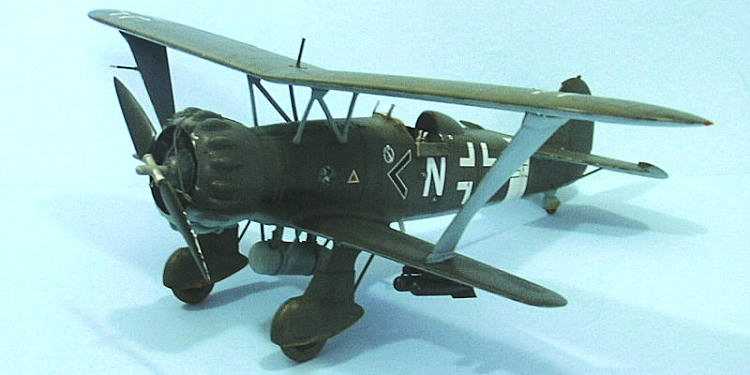
Montex 1/32 Henschel Hs-123A-1
| KIT #: | 32005 |
| PRICE: | $179.95 MSRP |
| DECALS: | Two options |
| REVIEWER: | Tom Cleaver |
| NOTES: | Full Resin kit |

| HISTORY |
Soon after Hitler came to power,
Henschel - to that point a locomotive manufacturer - decided to enter the
aircraft industry.
Following his demonstration of the Curtiss Hawk, Ernst
Udet convinced Erhard Milch to order a dive-bomber for the new Luftwaffe.
Henschel’s reply - in competition to the Fieseler Fi-98
- was the Hs 123, designed to meet the 1933 requirements which specified a
single-seat biplane dive-bomber. Udet flew the Hs 123V1 prototype on its first
public demonstration on May 8, 1935. The first three Henschel prototypes,
powered by the 650 hp BMW 132A-3 engines, were tested at Rechlin in August 1936.
The Hs-123 did away with bracing wires and although they looked outdated, they
featured a fully-cantilever, all- metal construction, clean lines and excellent
maneuverability.
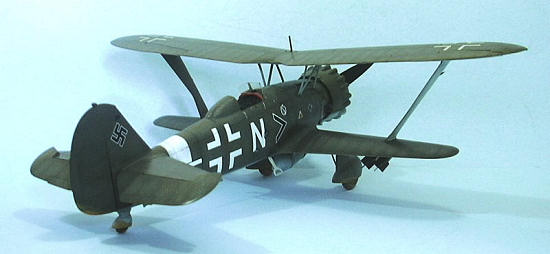 The performance of the Hs-123 V1
eliminated the more conventional Fi-98. During testing, the Hs-123 proved
capable of pulling out of "near-vertical" dives.
Two prototypes crashed due to wing failures. The
Hs-123V-4 incorporated stronger cabane struts to cure this. After successful
tests, the Hs-123 was ordered into production with an 880 hp BMW 132Dc engine.
The performance of the Hs-123 V1
eliminated the more conventional Fi-98. During testing, the Hs-123 proved
capable of pulling out of "near-vertical" dives.
Two prototypes crashed due to wing failures. The
Hs-123V-4 incorporated stronger cabane struts to cure this. After successful
tests, the Hs-123 was ordered into production with an 880 hp BMW 132Dc engine.
The Hs-123 was intended to replace
the Heinkel He-50 as well as be a "stop-gap" until the Junkers Ju-87 became
available. Thus, production was limited with no further development considered.
Production ended in October 1938 with 1000 aircraft.
A pre-production batch of Hs
123A-0s was produced in 1936 for service evaluation by the
Luftwaffe, and were followed by the slightly modified Hs
123A-1 series, which was equipped with an armoured headrest and fairing, as well
as removable main wheel spats and a faired tailwheel. The weapon load of four SC
50 110 lb bombs were carried on lower wing racks along with an additional SC250
550 lb (250 kg) bomb mounted on a "crutch" beneath the fuselage, though this was
usually replaced by a drop tank. Two MG 17 machine guns (7.92 mm/0.312 in) were
mounted in the nose synchronized to fire through the propeller arc.
The Hs-123A-0 entered service with
StG 162 “Immelmann”
in October 1936, serving until the unit re-equipped with the Ju-87 the following
year. Five Hs-123A-0 and A-1 aircraft were sent to Spain, where they proved
highly effective in the close-support role, proving capable of absorbing
punishment and getting home. The Spanish Nationalists were so impressed that
they purchased the five Condor Legion airplanes and eleven more.
Known as the “Angelito,” the Spanish Hs-123s served
until 1945, with one flown until the early 1950s. Twelve Hs-123s were exported
to China in 1938, where they saw extensive operation as dive bombers against
Japanese warships on the Yangtze River
In Spain, the aircraft proved
themselves capable of operating from primitive airstrips close to the front.
It was here that the pilots discovered that the most
potent weapon the Hs-123 had was its engine.
By changing revolutions on the controllable-pitch prop
while in a dive, the airplane could emit sounds that frightened men and horses
below, with calamitous results for the unit so attacked.
In 1938, the remaining Hs-123s were
part of the temporary Fliegergeschwader 100
during the Munich Crisis. With the crisis over, the Hs-123s were transferred to
Lehrgeschwader 2 as II.(Schl)/LG2.
In the invasion of Poland, the 39 Hs-123s of LG 2 proved
particularly effective at close-support, where they were instrumental in
breaking up attempts by Polish cavalry to attack
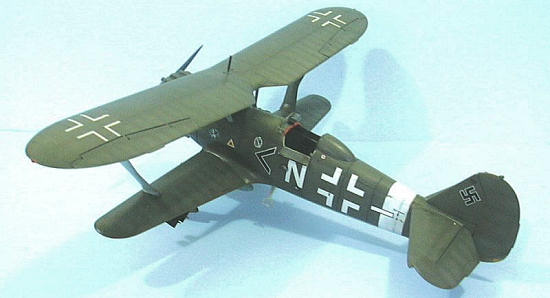 German
units, using the “staccato” sound discovered in Spain.
Flown from primitive fields close to the front, ground
crews considered the Hs-123 reliable and easy to maintain. The leading pilot of
this unit was Hauptmann Adolf Galland,
who was at the time seen as a ground-attack expert due to his service with the
He-51 in this role in the Condor Legion.
German
units, using the “staccato” sound discovered in Spain.
Flown from primitive fields close to the front, ground
crews considered the Hs-123 reliable and easy to maintain. The leading pilot of
this unit was Hauptmann Adolf Galland,
who was at the time seen as a ground-attack expert due to his service with the
He-51 in this role in the Condor Legion.
With their success in the Polish
campaign, the Hs-123s found a role in the Western Front
Blitzkrieg against France and the Low Countries, where
General Heinz Guderian was impressed by the quick turnaround time of
II.(Schl)/LG 2.
Usually the most-forward-based unit, the Hs-123s flew
more missions per day than any other type, and again proved their worth in the
close-support role. Ju-87s were still used as tactical bombers rather than true
ground support aircraft, so with no other capable aircraft available, the Hs 123
continued in service, though their numbers were constantly being reduced by
attrition.
At the end of the French campaign, II/LG2
returned to Germany to swap their Hs-123s for Bf-109E fighter-bombers, even
though all the pilots were convinced they were swapping out to a less-useful
aircraft.
At the outbreak of the Balkans
Campaign, the 32 Hs-123s that had been retired after the fall of France were
brought back to equip 10.(Schl)/LG 2.
They performed so well they remained in service for
Operation Barbarossa.
The single Gruppe
dedicated to ground support was II.(Schl)/LG 2,
which operated 38 Bf-109Es and 22 Hs-123s. In service on the Eastern Front in
the Central and Southern theaters, the remaining Hs-123s were "field" modified
with additional armor and carried extra machine guns and even 20mm cannons
underwing.
In January 1942,
II.(Schl)/LG 2 was redesignated as the first
dedicated ground attack Geschwader,
Schlact Geschwader 1, with the Hs-123s
being flown by 7./SG 1.
The unit flew in the Second Battle of Kharkov and
participated in the Battle of Stalingrad.
To make up losses, Hs-123s were being taken from
training schools and salvaged from derelict dumps.
In January, 1943, Generaloberst
Wolfram von Richthofen, commander of Luftflotte 4,
asked if the Hs-123 could be placed back in production because of its
performance where mud, snow, rain and ice took a heavy toll on more advanced
aircraft. Unfortunately, the Henschel factory had dismantled all tools and jigs
in 1940.
After participating in the Battle of Kursk, SG 1 returned to the Crimea, where they finally gave up the aircraft they had flown through five campaigns after it had been declared obsolete. In July 1944, 7./SG 1 traded its last Hs-123s for Ju-87s, the type that had “replaced” them back in 1937.
| THE KIT |
This Hs-123A-1 is the fifth
full-resin kit from Montex of Poland, following their Boomerang, Gloster
Gamecock, Hawker Fury, and Fairey Fawn.
As has been noted in reviews of the previous kits, these
are extremely-high-quality
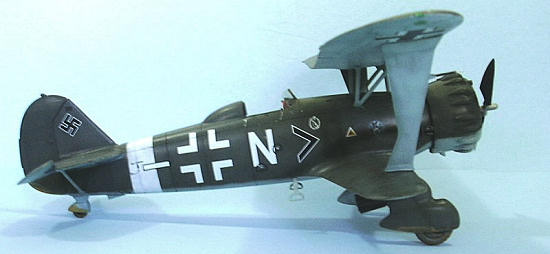 resin
kits, with lots of great detail.
In test-fitting this kit, I can see that assembly is so
easy and straightforward that any modeler who has had any experience at all
assembling resin parts would have no difficulty building this kit out of the box
into a show-stopper.
resin
kits, with lots of great detail.
In test-fitting this kit, I can see that assembly is so
easy and straightforward that any modeler who has had any experience at all
assembling resin parts would have no difficulty building this kit out of the box
into a show-stopper.
The cockpit is fully detailed,
lacking only seat belts which are available from Eduard.
The BMW 132 engine is also fully-detailed, to the point
where it is almost a crime to enclose it in the beautiful three-part cowling.
Parts fit is entirely positive, so
that it is impossible to get the dihedral of the upper wing wrong when
assembling the two parts.
All control surfaces are molded separately and can be
posed dynamically.
Masks are provided to all the model to be built as a Spanish Air Force “Angelito” in 1942, or a Hs-123A-1 of 7./SG 1 on the Eastern Front in 1942.
| CONSTRUCTION |
This kit from Montex is easily the
very best resin kit I have ever built.
There are manufacturers of injection-molded kits who
would wish on their happiest day that they had the ability to create a kit as
well-engineered as this kit is.
That said, in my initial review
in-box, I said the kit would only need filler on the fuselage centerline seam.
That wasn’t accurate.
It turned out to need a bit of Mr. Surfacer and
cyanoacrylate on all seams, but it needed a lot less than most limited-run
injection-molded kits. There were a couple of places - most notably in the
attachment of the upper wing - where I needed a good dose of “some modeling
skill required”, but it was nothing really difficult for anyone who has learned
“test-fit four times before gluing once.”
That said, the kit was really quite
easy to build.
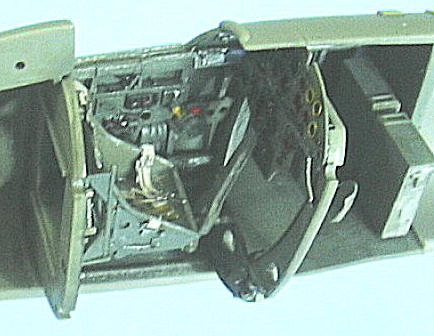 Construction started with the
cockpit.
I pre-painted everything in RLM02, then gave everything a wash of
thinned Tamiya “Smoke” to pop out detail, then did further weathering by
dry-brushing Tamiya “Flat Aluminum” to further “pop out” detail. I used Eduard’s
1/32 Luftwaffe seatbelts to finish things off.
Construction started with the
cockpit.
I pre-painted everything in RLM02, then gave everything a wash of
thinned Tamiya “Smoke” to pop out detail, then did further weathering by
dry-brushing Tamiya “Flat Aluminum” to further “pop out” detail. I used Eduard’s
1/32 Luftwaffe seatbelts to finish things off.
Once the cockpit was done, the
fuselage came together easily. I used some cyanoacrylate glue to fill the seam,
smoothed that with Mr. Surfacer, and then rescribed panel lines where necessary.
The engine was a model in itself,
with a separate crankcase, separate cylinders, and all other detail also
separate.
Everything fit perfectly. The exhaust detail was mostly lost when
the cowling was closed up around the engine, but careful viewing will show it’s
all in there.
The cowling seemed difficult at first, since it is a very close
cowl.
I “clicked” the upper third into position and glued it in, then “clicked
the other two parts, and only had to glue them along the mounting seams
externally.
I attached the horizontal stabilizers and the lower wings, then attached the control surfaces in dynamic positions. When all the seams were sanded smooth, the model was ready for paint.
| COLORS & MARKINGS |
Painting:
Lots of paint schemes for the
Hs-123 will tell you that it was in a RLM70 and RLM71 splinter pattern.
This is wrong - as they say in Texas, it is “Armadillo
patties.”.
All the airplanes were originally delivered in the three-tone
grey/brown/green scheme, which
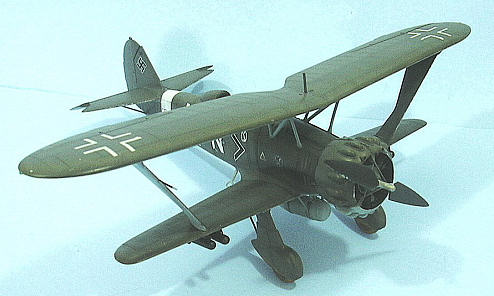 was
(according to the “X-purtz”) then overpainted in RLM70/71, and then later
overpainted in overall RLM71.
Well, baloney!
Their Gauleiterships
of the Reichluftfartministerium would
never have put that much effort into painting what they saw at the time as a
“second line” airplane.
The fact is that the only photos of Hs-123s that would
give credence to the 2-tone upper scheme are photos with shadows.
Sorry, dark shadow lines are NOT evidence of RLM70/71!
These were not airplanes the
Luftwaffe gave much of a rat’s patootie about.
Given that, they were most likely painted overall RLM71
from the git-go. (Anyone who can present a color photo
to disprove this will receive a great dinner as my guest at my favorite Los
Angeles French cuisine vegan restaurant, Madeleine’s Bistro.)
was
(according to the “X-purtz”) then overpainted in RLM70/71, and then later
overpainted in overall RLM71.
Well, baloney!
Their Gauleiterships
of the Reichluftfartministerium would
never have put that much effort into painting what they saw at the time as a
“second line” airplane.
The fact is that the only photos of Hs-123s that would
give credence to the 2-tone upper scheme are photos with shadows.
Sorry, dark shadow lines are NOT evidence of RLM70/71!
These were not airplanes the
Luftwaffe gave much of a rat’s patootie about.
Given that, they were most likely painted overall RLM71
from the git-go. (Anyone who can present a color photo
to disprove this will receive a great dinner as my guest at my favorite Los
Angeles French cuisine vegan restaurant, Madeleine’s Bistro.)
So I did a “pre-shading” withe flat
black, then did the model in overall RLM65 Hellblau
from Tamiya, and RLM71 Dunkelgrun with
Gunze, with both colors faded with multiple passes as I lightened the original
colors with white and light grey.
Decals:
I don’t like masks, and didn’t particularly like these as I studied photos of Hs-123s on the eastern front. So I went through that wing of the decal dungeon dedicated to 1/32 Luftwaffe, and found decals sufficient to cobble together my own markings, that being an Hs-123 on the southern front in the summer of 1942, from available photos.
| FINAL CONSTRUCTION |
I had test-fitted the upper wing
before painting, and thought it might go together as designed.
Once there was paint on the model and I could determine
how things were really fit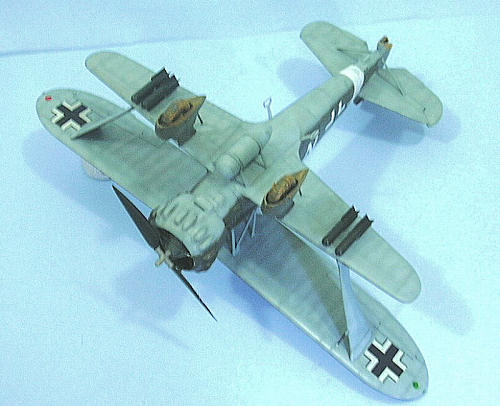 ting,
I had to cut off all the pegs on the wing struts and rear cabane struts, leaving
only the locating pegs of the forward cabane struts.
I then test-fitted several times as I sanded the rear
cabane struts and the interplane struts so they fit right.
With cyanoacrylate glue, everything went together
without a problem.
ting,
I had to cut off all the pegs on the wing struts and rear cabane struts, leaving
only the locating pegs of the forward cabane struts.
I then test-fitted several times as I sanded the rear
cabane struts and the interplane struts so they fit right.
With cyanoacrylate glue, everything went together
without a problem.
I then attached the windscreen, the
bomb racks, the bombs, and the prop, after giving a few “dings” to the airframe
and prop.
I applied exhaust staining with thinner Tamiya “Smoke.”
I “muddied” the wheels and spats with the Tamiya
weathering set.
| CONCLUSIONS |
I have built the Airfix Hs-123
in 1/72 scale, and several ESCI Hs-123s in 1/48 scale, including two of the
upgraded kits from AMTech, and can say that this is easily the best kit of this
airplane produced by anyone in any scale.
It is easy to assemble, even with all the small detail
parts, with no “wrestling” required.
If you like the Hs-123, or if you just want to build a
really excellent model that will allow your talents to shine in the final
product, this kit is well worth its price.
Review kit courtesy of Montex.
December 2008
If you would like your product reviewed fairly and quickly, please contact me or see other details in the Note to Contributors.